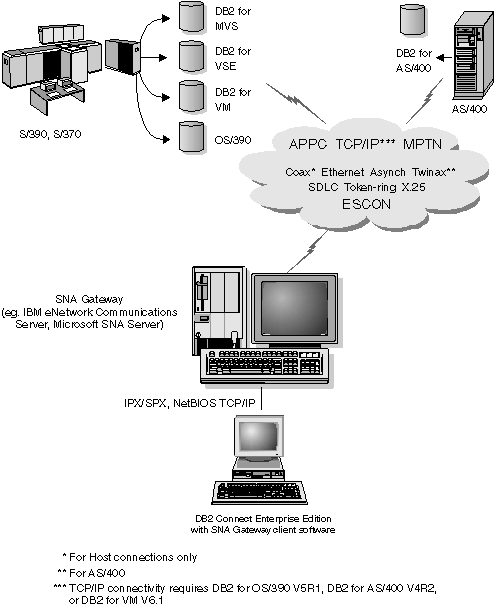
Installation and Configuration Supplement
Use the completed worksheet in Table 26 to configure DB2 Connect APPC
communications for access to a remote host or AS/400 database server.

| Go to the sections that describe how to configure APPC communications on
the platforms that are present in your network:
|
This section describes how to manually configure APPC
communications between your DB2 Connect for OS/2 workstation and host or
AS/400 database servers.
Before you begin, ensure that your workstation has CS/2 V5 or later for
OS/2 installed.

| The steps in this section describe how to use IBM eNetwork Communications
Server Version 5. If you have Communications Manager for OS/2
V.1.x, the steps you perform are similar, but the interface and
menu names are different.
|
For more information on setting up your environment, refer to the online
help supplied with CS/2, or to the following publications:
- Connectivity Supplement
- DRDA Connectivity Guide
The following assumptions have been made:
- The basic installation of the IBM eNetwork Communication Server V5 for
OS/2 package has already been completed.
- The DB2 Client for OS/2 has been installed.
Use the Your Values entries in the worksheet in Table 22 to complete the steps below.

| These instructions describe how to create new profiles within a new
configuration. If you are modifying an existing configuration, you may
need to delete some profiles before you can verify the configuration.
|
To configure your system, perform the following steps:
step 1.
| Start a new configuration
- Double-click on the IBM eNetwork Communications Server
icon.
- Double-click on the Communications Manager Setup icon.
- In the Communications Manager Setup window, click on the Setup
push button.
- In the Open Configuration window, provide a name for a new configuration
file and click on OK. The Communications Manager
Configuration Definition window opens.
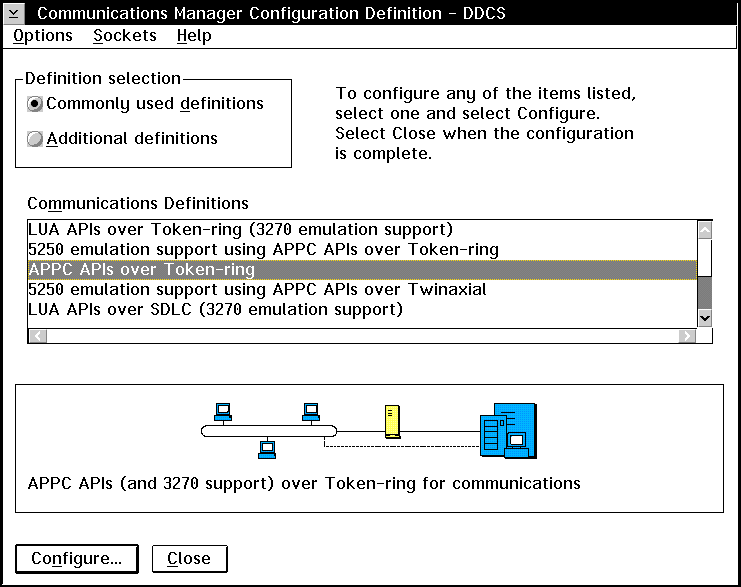
|
step 2.
| Configure the protocol
- Select the Commonly used definitions radio button.
- In the Communications Definitions box, select the protocol that you want
to use.

| These intructions use APPC APIs over Token-Ring.
|
APPC APIs over Token-Ring.
- Click on the Configure push button. The APPC APIs over
Token-Ring window opens.
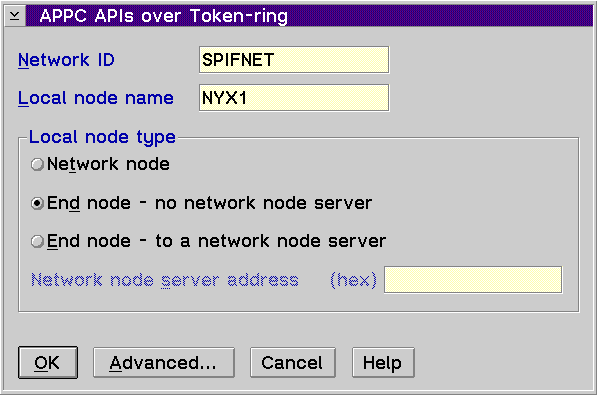
- Enter your Network ID ((9)) in the Network ID
field.
- Enter your local Control Point name ((10)) in the Control
point name field.
- Click on the End node push button that your network
administrator advises you to use.

|
You can select either the End node - to a network node server
radio button or the End node - no network node server radio
button. A network node server is used when many users are routed
through the same connection. This example assumes no network node
server is used.
|
- Click on the Advanced push button.

|
Subsequent steps begin from this window. You will return to this
window when each of the following steps are completed.
|
The Communication Manager Profile List window opens.
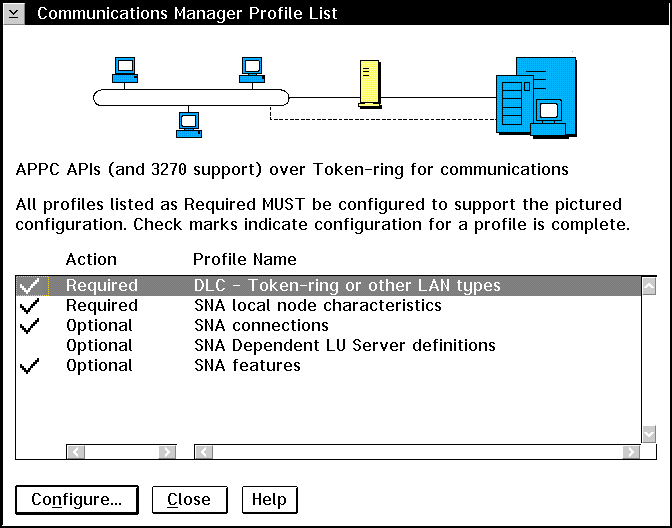
|
step 3.
| Prepare a LAN DLC profile
- On the Profile List window, select the DLC - Token ring or other LAN
Types Adapter Parameters option and click on the Configure
push button. The Token Ring or Other Lan Types Adapter Parameters
window opens.
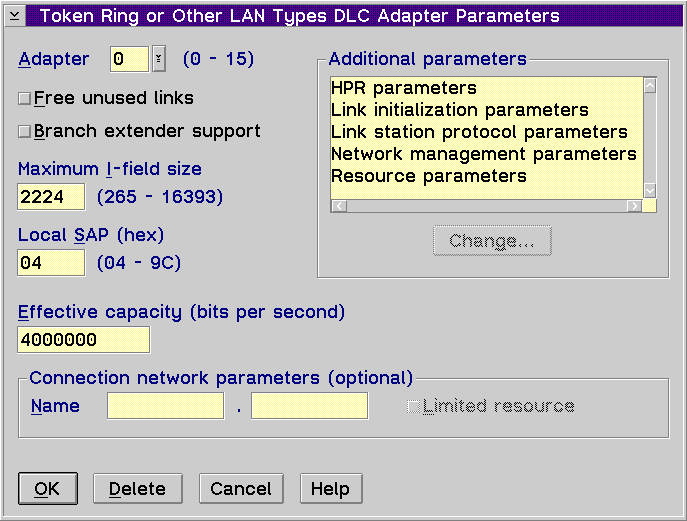
- Enter your Network ID ((9)) in the Network ID
field.
- Click on OK.
|
step 4.
| Update the SNA local node characteristics
- On the Profile List window, select the SNA local node
characteristics option and click on the Configure push
button. The Local Node Characteristic window opens.
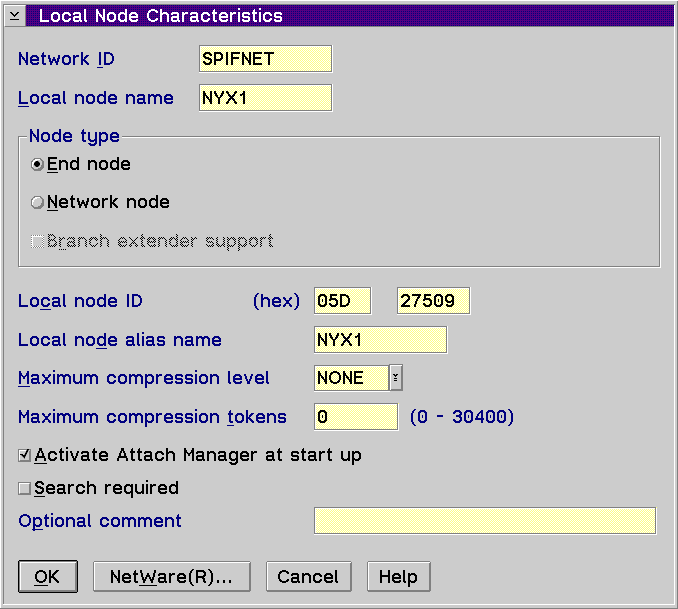
- Enter your Network ID ((9)) in the Network ID
field.
- The Local node name was probably set when CS/2 was installed. If
you are not sure, consult your local network administrator.
- Enter your Node ID ((13), (14)) in the Local node ID
(hex) field.

|
The first part should be filled in for you already when you display the
profile. You only need to complete the second part.
|
- Click on OK.
|
step 5.
| Prepare the SNA Connection Profiles
- On the Profile List window, select the SNA Connections option
and click on the configure push button. The Connection List
window opens.
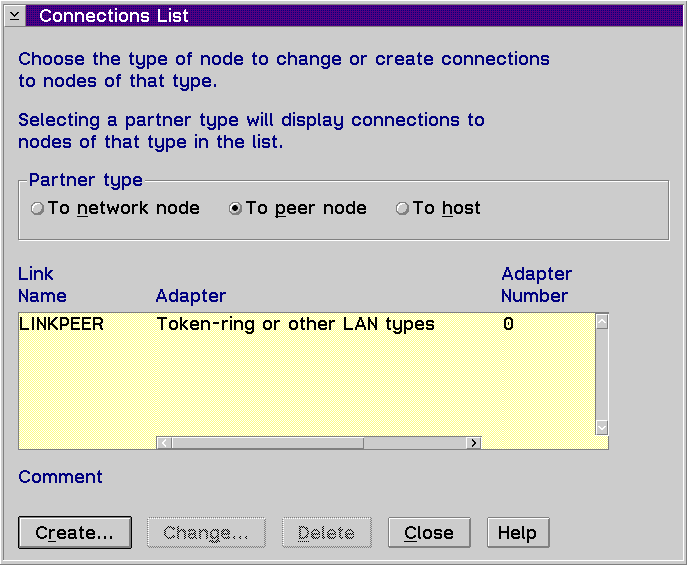
- From the Partner Type window, select either the To peer
node radio button (normally used for OS/400 connections), or the To
host radio button (normally used for OS/390, MVS, VSE, and VM
connections), and click on the Create push button. The
Adapter List window opens.
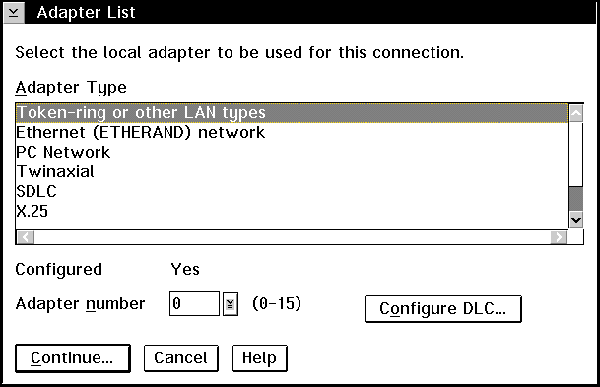
- Select the Token-ring, or other LAN types Adapter Type, and
specify the same adapter number that you specified previously in the DLC
profile.
- Click on the Continue push button. The Connection to a
Peer Node window or the Connection to a Host window opens.
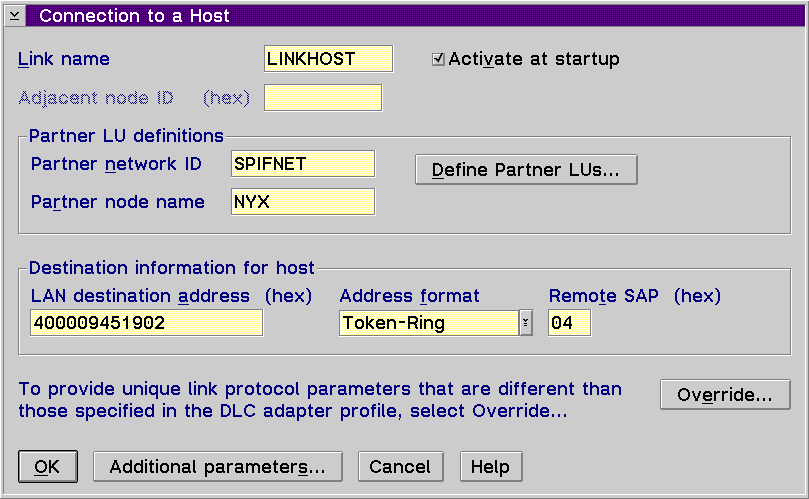
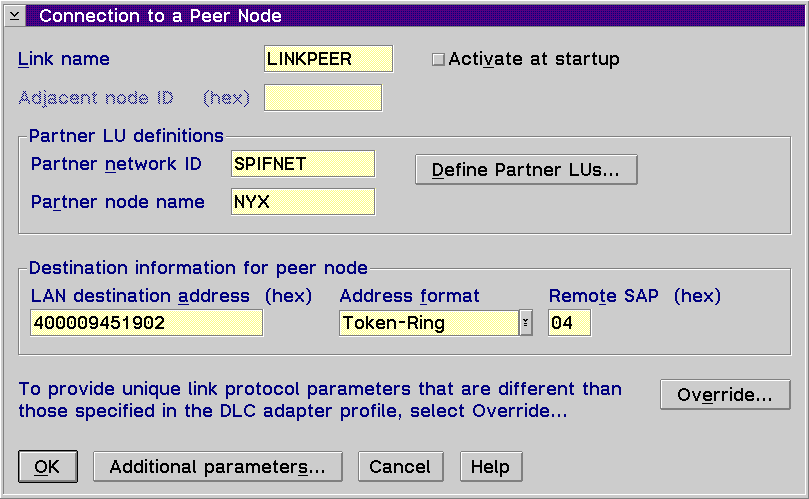
|
step 6.
| Configure the connection in the Connection to a Peer Node or Connection to
Host window
- Enter the Link name ((7)) in the Link name field.
- In the Connection window, click on the Additional parameters
push button. The Additional Connection Parameters window
opens.
- Enter your local Control Point name ((10)) in the Local PU
name field.
- Clear the Backup Link check box.
- Enter your Node ID ((13) and (14)) in the Node ID
fields.
- Click on OK.
- Enter the remote LAN address ((8)) in the LAN destination
address field.
- Enter the Network ID ((1)) of the remote system in the Partner
network ID field.
- Enter the Partner Node name ((4)) in the Partner node
name field.
- Click on the Define Partner LUs push button. The Partner
LU window opens.
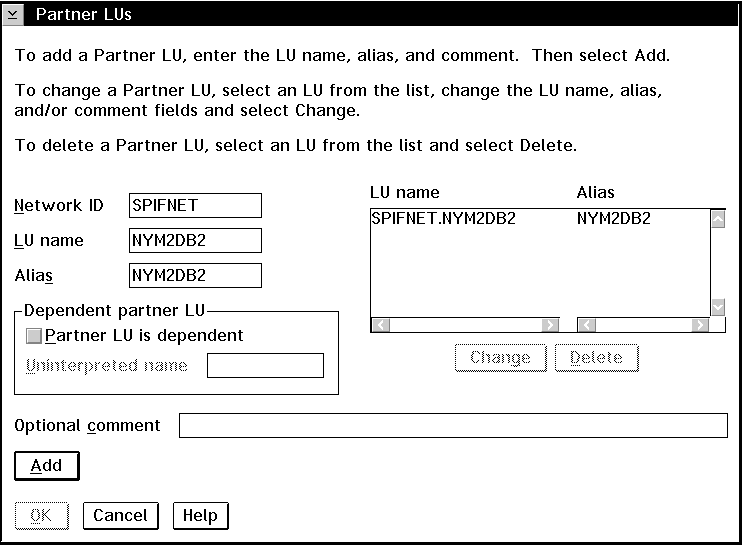
|
step 7.
| Create a partner LUs profile
- Enter the Network ID ((3)) of the remote system in the Network
ID field.
- Enter the Partner LU name ((2)) in the LU name and
Alias fields.
- Click on the Add push button to add the partner LU profile to
the connection profile.
- Click on OK.
- Click on the Additional Parameters push button. The
Additional Connection Parameters window opens.
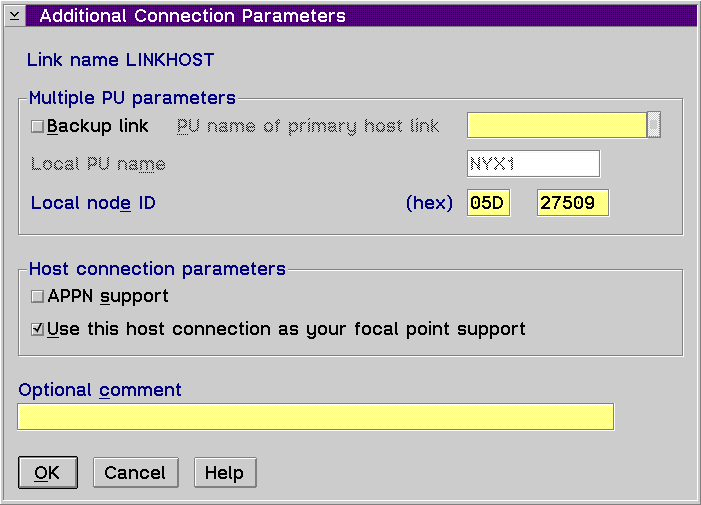
- Verify that the Multiple PU Parameters fields are filled
in. This value is the Local Node ID in hex ((13) and
(14)).
- Click on OK to return to the Connection window.
- Click on OK to return to the Connections List window.
- Click on the Close push button to return to the Profile List
window.
|
step 8.
| Set SNA features
- On the Profile List window, select the SNA features option and
click on the Configure push button. The SNA Features List
window opens. Subsequent steps begin from this window.
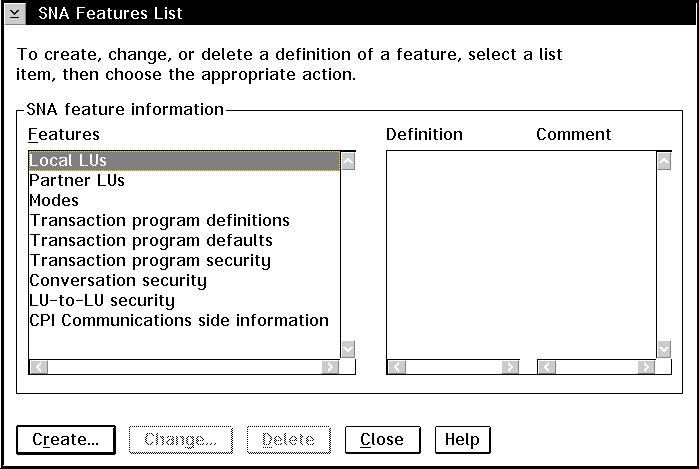
|
step 9.
| Prepare a local LU profile
If the DB2 workstation is defined as an independent LU, prepare a Local LU
Profile by performing the following steps:
- On the SNA Features List window, select Local LUs->Create from
the action menu bar.
- Enter your Local LU name ((11)) in the LU name
field.
- Enter your Local LU alias ((13)) in the alias
field.
- Select the Independent LU radio button in the NAU
address box.
- Click on OK.
- To use this local LU when the DB2 Connect workstation starts the APPC
connection, select the Use this local LU as your default local LU
alias check box. By default, all APPC connections that are
started from this DB2 Connect workstation will use this local LU.
|
step 10.
| Prepare a mode definition
- From the SNA Features List box, select the Modes option and
click on the Create push button. The Mode Definition window
opens.
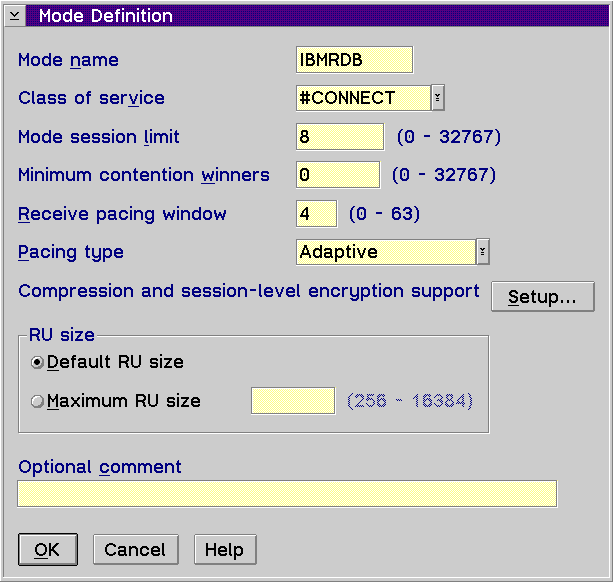
- Enter your Mode name ((6), (15)) in the mode name
field.
- For the other fields, you can either specify values that match the mode
profile defined on your server systems, or tune the parameters.
- Click on OK to finish the creation of the mode and to return to
the SNA Features List panel.
|
step 11.
| Create the CPIC side information
- From the SNA Features List box, select the CPI Communications Side
Information option and click the Create push button.
The CPI Communications Side Information window opens.
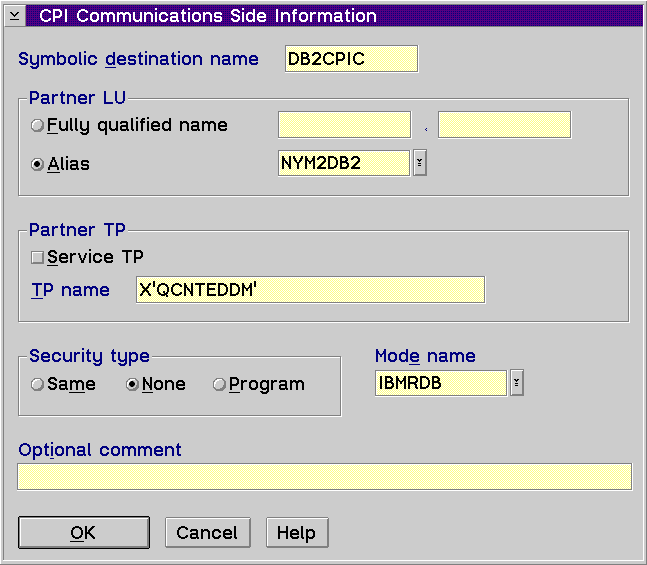
- Enter the Symbolic destination name ((16)) in the Symbolic
destination name field.
- Select the Alias radio button.
- Click on the Alias drop down box and select your Local LU alias
((12)).
- Enter the remote Transaction Program (TP) name ((17)) in the
Partner TP field.
- Select the None radio button in the Security type
group.

|
This does not mean that you will have no security. You will specify
the security type later when you update the DB2 directories.
|
- Enter the mode name ((6)) in the Mode name field.
- Click on OK to save the CPI side information profile and return
to the SNA Features List panel.
- Click on Close to return to the Communications Server Profile
List panel.
|
step 12.
| Save the configuration
- Click on the Close button to return to the Comminucation Server
Configuration Definition window.
- Click on the Close button to automatically verify and save the
new configuration file, and leave the configuration windows.
- Stop and start Communications Server by selecting Stop Communications
Normally->Start Communications from the action menu bar.
|
This section describes how to configure IBM Personal Communications for
Windows NT, Windows 98 and Windows 95 on your DB2 Connect workstation to
connect to host or AS/400 database servers using APPC.
Before you begin, ensure that the IBM Personal Communications for Windows
NT or Windows 9x you installed meets the following requirements:
__ 1.
| It is Version 4.2 or higher
|
__ 2.
| The IBM Personal Communications IEEE 802.2 LAN interface is
installed (this is an installation option for IBM Personal Communications)
|
__ 3.
| The LLC2 driver is installed from the IBM Communications Server
installation directory. To confirm this:
- Click on the Start push button, then select
Settings->Control Panel.
- Double-click on the Network icon.
- On the Network window, click on the Protocols tab.
IBM LLC2 Protocol must be one of the protocols listed. If it
is not, you need to install this protocol from your IBM Personal
Communications for Windows NT or Windows 9x software. Refer to the
documentation supplied with IBM Personal Communications for
instructions.
|
The following assumptions are made:
- The basic installation of the IBM Personal Communication package has
already been completed, with the requirements listed above met.
- DB2 Connect has been installed.
To start IBM Personal Communications, perform the following steps:
step 1.
| Click Start and select Programs->IBM Communications
Server->SNA Node Configuration. The IBM Personal Communications
SNA Node Configuration window opens.
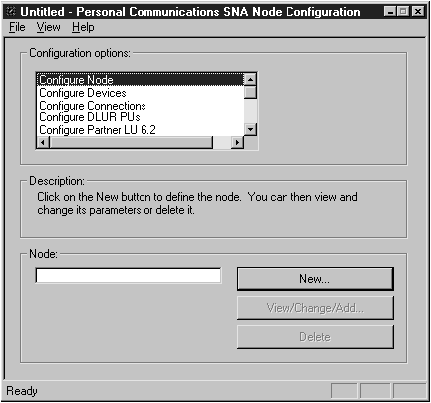
|
step 2.
| Select File->New from the menu bar. The Define the Node
window opens. Subsequent steps will begin from this window.
|
To configure APPC communications, complete the following steps:
step 1.
| Configure the Node
- In the Configuration options box, select Configure
Node, then click on the New push button. The Define
the Node window opens.
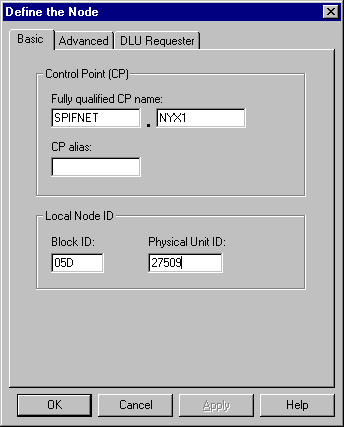
- In the Fully qualified CP name fields, type in the network name
(9) and the local control point name (10)
(SPIFNET.NYX1).
- Optionally, in the CP alias field, type in a CP alias.
If you leave this blank the local control point name (10) will be used
(NYX1).
- In the Local Node ID fields, type in the block ID (13)
and the physical unit ID (14) (05D 27509).
- Click on OK.
|
step 2.
| Configure the device
- In the Configuration options box, select Configure
devices.
- Select the appropriate DLC from DLCs field. These
instructions use the LAN DLC.
- Click on the New push button. The appropriate window
opens with default values displayed. In this case, the Define a LAN
device window opens.
- Click on OK to accept the default values.
|
step 3.
| Configure Connections
- In the Configuration options box, select Configure
connections.
- Ensure that in the DLCs field, LAN is
highlighted.
- Click on the New push button. The Define a LAN
connection window opens.
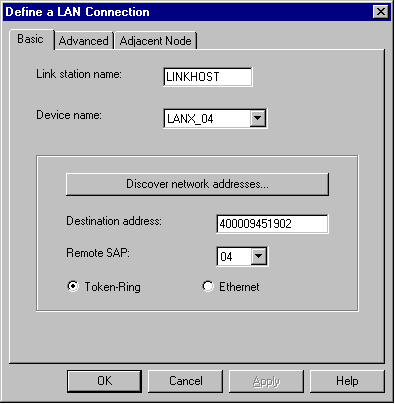
- On the Basic tab panel:
- In the Link station name field, type in the name (7)
from the worksheet (LINKHOST).
- In the Destination address field, type in the address
(8) from the worksheet (400009451902).
- On the Adjacent Node tab panel:
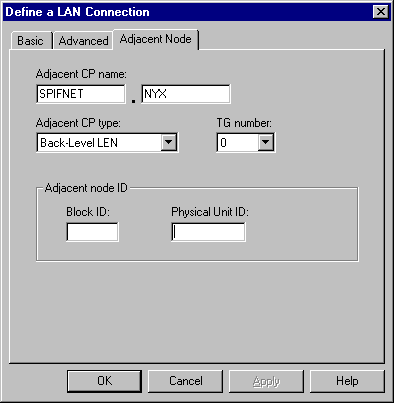
- In the Adjacent CP name fields, type in the network ID
(3) and the Control Point name (4)
(SPIFNET.NYX).
- In the Adjacent CP type field, select Back-level
LEN.
- Ensure that TG number is set to 0 (the
default).
- Click on OK.
|
step 4.
| Configure Partner LU 6.2
- In the Configuration options box, select Configure partner
LU, then click on the New push button. The Define a
partner LU 6.2 window opens.
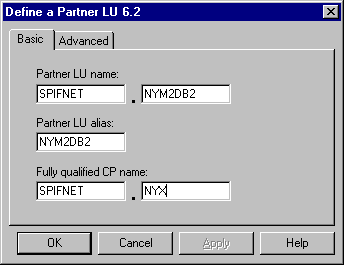
- In the Partner LU name fields, type in the network ID
(3) and the partner LU name (2)
(SPIFNET.NYM2DB2).
- In the Partner LU alias field, type in the partner LU name
(2) from the worksheet (NYM2DB2).
- In the Fully-qualified CP name fields, type in the network ID
(3) and the adjacent control point SSCP name (4)
(SPIFNET.NYX).
Accept the defaults in the Advanced tab panel.
- Click on OK.
|
step 5.
| Configure Modes
- In the Configuration options box, select Configure
modes, then click on the New button. The Define a mode
window opens.
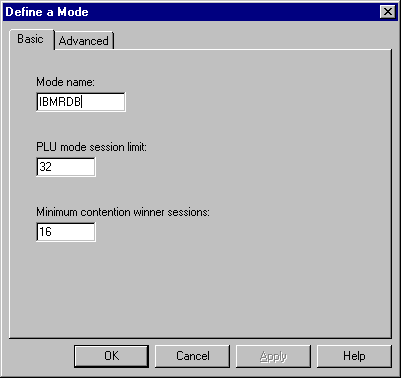
- Enter your Mode name ((15)) in the Mode name field of
the Basic tab.
- Select the Advanced tab.
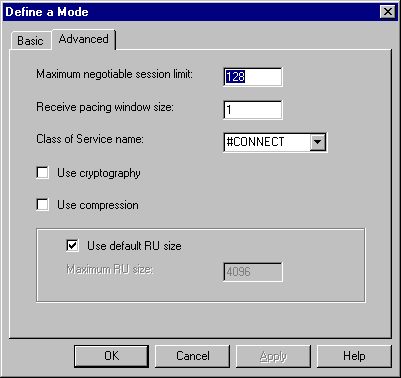
- Select #CONNECT from the Class of Service Name
field.
- Click on OK.
|
step 6.
| Configure Local LU 6.2
- In the Configuration options box, select Configure local
LU 6.2, then click on the New button. The
Define a local LU 6.2 window opens.
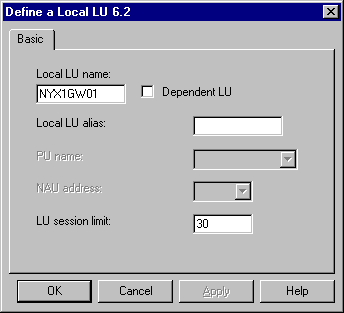
- Enter your Local LU name ((11)) in the Local LU name
field.
- Type in a value for the LU session limitfield. The
default, 0, specifies the maximum allowed value. Accept the
defaults for the other fields.
- Click on OK.
|
step 7.
| Configure CPI-C Side Information
- In the Configuration options box, select Configure CPI-C
side information, then click on the New push button.
The Define CPI-C side information window opens.
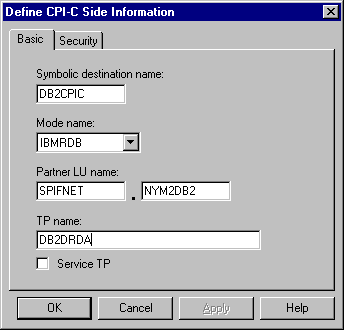
- In the Symbolic destination name field, type in the name
(16) from the worksheet (DB2CPIC).
- In the Mode name field, type in the name (15) from the
worksheet (IBMRDB).
- In the Partner LU Name fields, type the Net ID (3) in
the first field, and the Partner LU Name (2) (SPIFNET.NYM2DB2)
in the second field.
- Specify the TP name. In the TP name field:
- To specify a non-service TP, in the TP name field, type in the
name of the non-service TP, for example DB2DRDA, and ensure that
there is no check mark in the Service TP check
box.
- To specify a service TP, in the TP name field, type in the name
of the service TP, for example 076DB, and ensure that there
is a check mark in the Service TP check box.
Accept the defaults for the other fields.
- Click on OK.
|
step 8.
| Save the Configuration
- Select File->Save As. The Save As window opens.
- Type in a file name, for example ny3.acg, then click on
OK.
- In the dialog box that appears, you are asked if you want this
configuration to be the default. Click on the Yes
button.
|
step 9.
| Update the environment
IBM Personal Communications uses an environment variable called
appcllu to set the default Local LU used for APPC
communications. You may set this variable on a per-session basis by
opening a command window and typing set
appcllu=local_lu_name, where local_lu_name is the name
of the local LU you want to use. However, you will probably find it
more convenient to permanently set the variable. To permanently set the
variable in Windows NT, perform the following steps:
- Click on the Start push button and select
Settings->Control Panel.
- Double-click on the System icon. The System Properties window
opens.
- Select the Environment tab.
- Type appcllu in the Variable field.
- Type your local LU name ((4)) in the Value field.
- Click on the Set push button to accept the changes.
- Click on OK to exit the System Properties window.
The environment variable will now remain set for future sessions.
|
step 10.
| Start SNA Node Operations
- Click on the Start push button and select Programs->IBM
Personal Communications->Administrative and PD Aids->SNA Node
Operations. The Personal Communications SNA Node Operations
window opens.
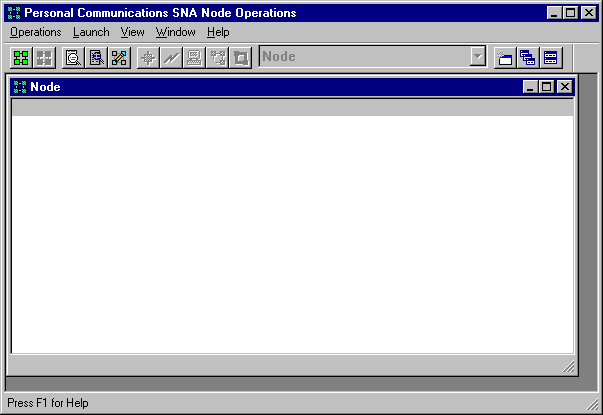
- From the menu bar, select Operations->Start Node.
- In the window that opens, select the configuration file you saved in the
previous step (for example, ny3.acg) and click on
OK.
|
Before you begin, ensure that the IBM eNetwork
Communications Server for Windows NT (CS/NT) you installed meets the following
requirements:
__ 1.
| It is Version 5.0 or higher if you are planning to update multiple
databases within the same transaction; if you are planning to use 2-phase
commit then Version 5.01 of CS/NT is required
|
__ 2.
| The IBM Communications Server IEEE 802.2 LAN interface was
installed (this is an installation option for Communications Server)
|
__ 3.
| The APAR fixes JR11529 and J$11170 were applied. These fixes are
required to enable cancelling of queries in progress by using Ctrl-BREAK or
issuing the SQLCancel ODBC/CLI call.
|
__ 4.
| The LLC2 driver was installed from the CS/NT installation
directory. During installation CS/NT asks if you want to install
LLC2. If you are not sure whether LLC2 was installed with your copy of
CS/NT, you can find out as follows:
- Click on the Start push button, then select
Settings->Control Panel.
- Double-click on the Network icon.
- On the Network window, click on the Protocols tab.
IBM LLC2 Protocol must be one of the protocols listed. If it
is not, you need to install this protocol from your IBM Communications Server
for Windows NT software. Refer to documentation supplied with CS/NT for
instructions.
|
To start IBM eNetwork Personal Server, perform the following steps:
step 1.
| Click on the Start button and select Programs->IBM
Communications Server-> SNA Node Configuration. The IBM
Communications Server SNA Node Configuration window opens.
|
step 2.
| Select File->New->Advanced from the menu bar. The
Configuration options window opens. Subsequent steps will
begin from this window.
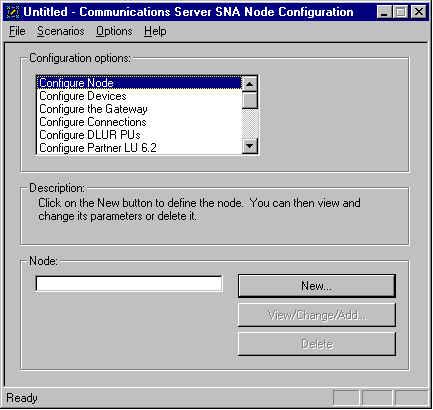
|
To configure IBM eNetwork Personal Server for APPC communications, complete
the perform the following steps:
step 1.
| Configure Node
- In the Configuration options field, select Configure
Node, then click on the New push button. The Define
the Node window appears.
- In the Fully qualified CP name fields, type in the network name
((9)) and the local control point name ((10))
(SPIFNET.NYX1).
- Optionally, in the CP alias field, type in a CP alias.
If you leave this blank the local control point name ((10)) will be
used (NYX1).
- In the Local Node ID fields, type in the block ID ((13))
and the physical unit ID ((14)) (05D.27509).
- Select the appropriate node type. The default is to select the
End Node radio button.
- Click on OK.
|
step 2.
| Configure Devices
- In the Configuration options field, select Configure
devices.
- Ensure that in the DLCs field, the appropriate DLC is
highlighted. For example, LAN.
- Click on the New push button. The appropriate window
appears with default values displayed. For example, the Define a LAN
device window.
- Click on OK to accept the default values.
|
step 3.
| Configure the Gateway

| You need to perform this step only if you are setting up Communications
Server to accept requests from Communications Server for Windows NT SNA
Client, as described in the your DB2 Connect Quick Beginnings
manual.
|
- In the Configuration options field, select Configure the
Gateway, then click on the New push button. The Define
Gateway window appears.
- Click on the SNA Clients tab.
- Ensure that there is a check mark in the Enable SNA API Client
Services check box.
- Click on OK to accept the default values.
|
step 4.
| Configure Connections
- In the Configuration options field, select Configure
connections.
- Ensure that in the DLCs field, LAN is
highlighted.
- Click on the New push button. The Define a LAN
connection window appears.
- On the Basic tab panel:
- In the Link station name field, type in the name ((7))
from the worksheet (LINKHOST).
- In the Destination address field, type in the address
((8)) from the worksheet (400009451902).
- On the Security tab panel:
- In the Adjacent CP name fields, type in the network ID
((3)) and the Control Point name ((4))
(SPIFNET.NYX).
- In the Adjacent CP type field, select the appropriate CP type
(eg. Back-level LEN).
- Ensure that TG number is set to 0 (the
default).
- Click on OK.
|
step 5.
| Configure Partner LU 6.2
- In the Configuration options field, select Configure
partner LU, then click on the New button. The Define a
partner LU 6.2 window appears.
- In the Partner LU name fields, type in the network ID
((3)) and the partner LU name ((2))
(SPIFNET.NYM2DB2).
- In the Partner LU alias field, type in the partner LU name
((2)) from the worksheet (NYM2DB2).
- If you are configuring Communications Server for SNA Clients, in the
Fully-qualified CP name fields, type in the network ID ((3))
and the adjacent control point SSCP name ((4))
(SPIFNET.NYX).
Leave the other fields blank.
- Click on OK.
|
step 6.
| Configure Modes
- In the Configuration options field, select Configure
modes, then click on the New button. The Define a mode
window appears.
- In the Mode name field ((6)), type in the mode name
(IBMRDB).
- Click on the Advanced tab and ensure that the Class of
Service Name is set to #CONNECT.
Accept the defaults for the other fields.
- Click on OK.
|
step 7.
| Configure Local LU 6.2
- In the Configuration options field, select Configure local
LU 6.2, then click on the New button. The
Define a local LU 6.2 window appears.
- In the Local LU name field, type in the name ((11)) from
the worksheet (NYX1GW01).
- Type in a value for the LU session limit field. The
default, 0, specifies the maximum allowed value.
Accept the defaults for the other fields.
- Click on OK.
|
step 8.
| Configure CPI-C Side Information
- In the Configuration options field, select Configure CPI-C
side information, then click on the New button. The
Define CPI-C side information window appears.
- In the Symbolic destination name field, type in the name
((16)) from the worksheet (DB2CPIC).
- In the Mode name field, type in the name ((15)) from the
worksheet (IBMRDB).
- Click on the radio button beside Use Partner LU alias and
select a Partner LU alias.
- Specify the TP name. In the TP name field:
- To specify a non-service TP, in the TP name field, type in the
name of the non-service TP, for example DB2DRDA, and ensure that
there is no check mark in the Service TP check
box.
- To specify a service TP, in the TP name field, type in the name
of the service TP, for example 076DB, and ensure that there
is a check mark in the Service TP check box.
Accept the defaults for the other fields.
- Click on OK.
|
step 9.
| Save the Configuration
- Select File->Save as from the menu bar. The Save As
window appears.
- Type in a file name, for example ny3.acg
- Click on OK.
- In the window that opens you are asked if you want this configuration to
be the default. Click on the Yes push button.
|
step 10.
| Update the Environment
IBM Personal Communications uses an environment variable called
appcllu to set the default APPC Local LU. You may set this
variable on a per-session basis by opening a command window and typing
set appcllu=local_lu_name, however you will probably find
it more convenient to permanently set the variable. In order to
permanently set the variable in Windows NT, complete the following
steps:
step a.
| Click the Start push button and select Settings->Control
Panel. Double-click on the System icon. When
the System Properties window appears, select the
Environment tab.
| step b.
| Type appcllu in the Variable field, and type your
local LU name ((11)) in the Value field.
| step c.
| Click Set to accept the changes then click OK to
exit the System Properties window.
|
The environment variable will now remain set for future sessions.
|
step 11.
| Start SNA Node Operations
To start SNA node operations on your machine, complete the following
steps:
step a.
| Click on the Start push button, then select Programs->IBM
Communications Server->SNA Node Operations. The SNA Node
Operations window opens.
| step b.
| From the menu bar, click on Operations and select Start
Node. In the dialog box that opens, select the configuration file
you saved at the end of Step 2 (in our example,
ny3.acg). Click OK.
|
SNA node operations will now begin running.
|
step 12.
| Registering Communications Server as a Windows NT Service
To automatically start Communications Server when the machine is booted,
you can register it as a Windows NT Service.
To register Communications Server as an NT service execute one of the
following commands:
csstart -a
to register Communications Server with the default configuration,
or:
csstart -a c:\ibmcs\private\your.acg
where c:\ibmcs\private\your.acg represents the
fully qualified name of the non-default Communications Server configuration
file you want to use.
Whenever your machine is booted in the future, Communications Server will
be started automatically with the required configuration file.
|
Read this section if you have a Windows NT workstation that has IBM
eNetwork Communications Server for Windows NT SNA API Client Version
5.0 or higher installed and you want to connect to an IBM eNetwork
Communications Server for Windows NT server.
The Communications Server for Windows NT server and its SNA API client act
as a split client. This configuration requires that you have an
APPC-enabled application (such as DB2 Connect) running on the SNA API client
workstation.

| The instructions in this section use a Windows NT client. The
instructions for other supported operating systems are similar; refer to your
Communications Server for Windows NT documentation for more
information.
|
To configure the Windows NT SNA API client for APPC communications,
complete the following steps:
step 1.
| Create a user account for the SNA API client on the Communications Server
for Windows NT server
- Click on the Start button and select
Programs->Administrative Tools (Common)->User Manager. The
User Manager window opens.
- Select Users->New User from the menu bar. The New User
window opens.
- Fill in the fields for the new SNA client user accout. For more
information, refer to the Windows NT online help.
- Ensure that this user account is a member of the
Administrators, IBMCSADMIN, and IBMCSAPI
groups:
- Click on the Groups push button
- Select a group from the Not member of box and click on the
<- Add push button. Repeat this step for each group that
your user account must belong to.
- Click on OK.
- Click on the Add push button.
|
step 2.
| Start the configuration GUI for the IBM eNetwork CS/NT SNA API
Client. Click on the Start push button and select
Programs->IBM Communications Server SNA
Client->Configuration. The CS/NT SNA Client Configuration window
opens.
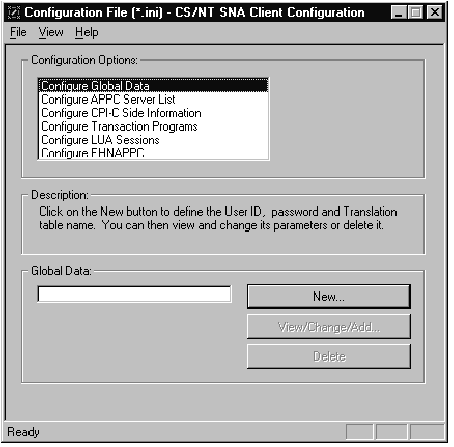
|
step 3.
| Configure Global Data
- In the Configuration options box, select the Configure
Global Data option and click on the New push button.
The Define Global Data window opens.
- Enter the user name for the SNA API client in the User name
field. This is the user name that was defined in Step 1.
- Enter the password for the user account in the Password and
Confirm Password fields.
- Click on OK.
|
step 4.
| Configure APPC Server List
- In the Configuration options box, select the Configure
APPC Server List option. Click on the New push
button. The Define APPC Server list window appears.
- Type in the IP address of the server (for example,
123.123.123.123).
- Click on OK.
|
step 5.
| Configure CPI-C Side Information
- In the Configuration options box, select the Configure
CPI-C side information option and click on the New push
button. The Define CPI-C side information window opens.
- Enter the symbolic destination name ((16)) in the Symbolic
destination name field.
- Enter your Local LU alias ((12)) in the Local LU alias
field.
- Enter the mode name ((15)) in the Mode name
field.
- Enter the transaction program name ((17)) in the TP name
field.
- Select the For SNA API Client use check box for this
transaction program.
- Enter the network ID ((3)) and partner LU name ((2)) in the
Partner LU name field.
- Click on OK.
|
step 6.
| Save the Configuration
- Select File->Save As from the menu bar. The Save As
window opens.
- Type in a file name, and click on the Save push button.
|
This section describes how to configure Microsoft SNA Server Version
4.0 for Windows NT on your DB2 Connect workstation to connect to host
or AS/400 database servers using APPC. Although Microsoft SNA Server
will run on Windows NT 4.0 Workstation, Windows NT 4.0 Server is
recommended.
You can define the properties of your SNA connections in the Microsoft SNA
Server Manager (Server Manager). The Server Manager uses an interface
similar to that of the Windows NT Explorer. The following illustration
shows the interface. There are two panes in the main window of the
Server Manager. All the configuration options we will be using can be
accessed by right-clicking on objects in the left-hand pane of the
window. Every object has a context menu that you can access
by right-clicking on the object.
To configure APPC communications for use by DB2 Connect using Microsoft SNA
Server Manager, perform the following steps:
step 1.
| Start the Server Manager by clicking on the Start button and
selecting Programs->Microsoft SNA Server->Manager. The
Microsoft SNA Server Manager window opens.
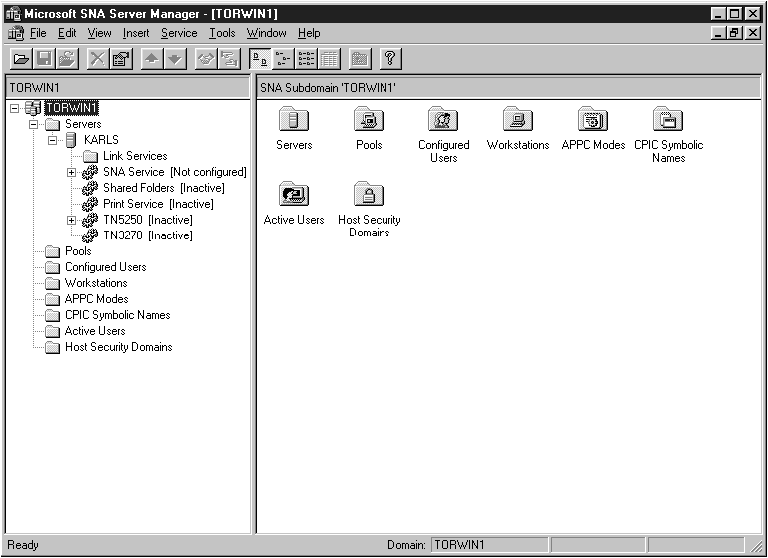
|
step 2.
| Define the control point name
- Click on the [+] sign beside the Servers
folder.
- Right-click on SNA Service folder and select the
Properties option. The Properties window opens.
- Enter the correct NETID ((9)) and Control Point
Name ((10)) in the corresponding fields.
- Click on OK.
|
step 3.
| Define the link service (802.2)
- Right-click on the SNA Service icon and select the
Insert->Link Service option. The Insert Link Service window
opens.
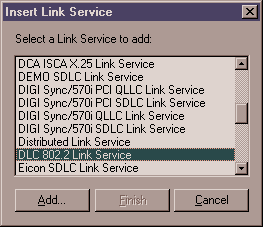
- Select DLC 802.2 Link Service.
- Click on the Add push button.
- Click on the Finish push button.
|
step 4.
| Define the connection properties
- Right-click on SNA Service and select the
Insert->Connection->802.2 option. The Connection
Properties window opens.
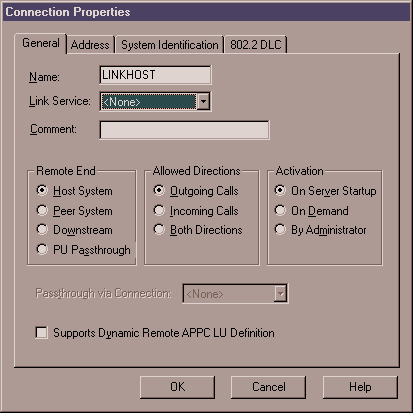
- Enter a connection name ((7)) in the Name field.
- Click on the Link Service drop-down box and select the
SnaDlc1 option.
- Select the Remote End radio button from the Host
System box.
- Select the Both Directions radio button from the Allowed
Directions box.
- Select the On Server Startup radio button from the
Activation box.
- Select the Address tab.
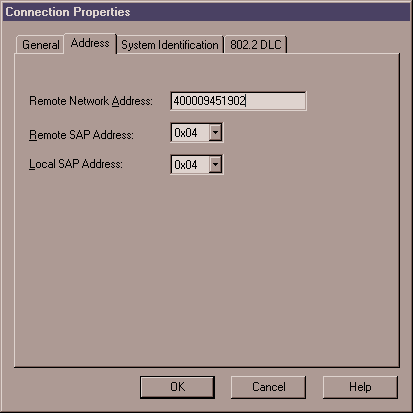
- Fill in the Remote Network Address field ((8)).
Accept the default numbers in the other fields.
- Select the System Identification tab.
- Enter the following information:
- For the Local Node Name, add the Network ID
((9)), the Local PU Name ((10)), and the Local
Node ID ((1) plus (14)). Accept the XID
Type default.
- For the Remote Node Name, add the NETID ((1))
and the Control Point Name ((4)). Accept the other
defaults
- Click on OK.
|
step 5.
| Define a local LU
- Right-click on the SNA Service icon and select the
Insert->APPC->Local Lu option. The Local APPC LU Properties
window opens.
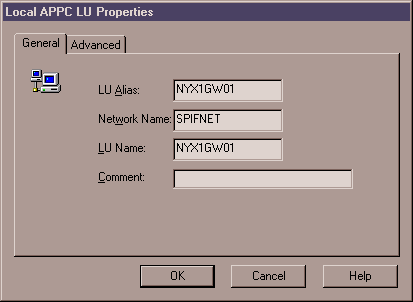
- Enter the following information:
- The LU Alias ((12)).
- The NETID ((9)).
- The LU Name ((11)).
- Select the Advanced tab.
- Select the Member of Default Outgoing Local APPC LU Pool
option. Accept the other defaults.
- Click on OK.
|
step 6.
| Define a remote LU
- Right-click on SNA Services icon and select the
Insert->APPC->Remote LU option. The Remote APPC Lu
Properties window opens.
- Click on the Connection drop down box and select the
appropriate connection name ((7)).
- Enter the partner LU name ((2)) in the LU Alias
field.
- Enter the Network ID ((1)) in the Network Name
field.

| The other fields will be filled in by the program. If your LU
alias is not the same as your LU Name, make sure you specify the LU Name in
the appropriate field. The program will fill it in automatically, but
it will be incorrect if the alias and the name are not the same.
|
- Click on OK.
|
step 7.
| Define a mode
- Right-click on APPC Modes folder and select the
Insert->APPC->Mode Definition option. The APPC Mode
Properties window opens.
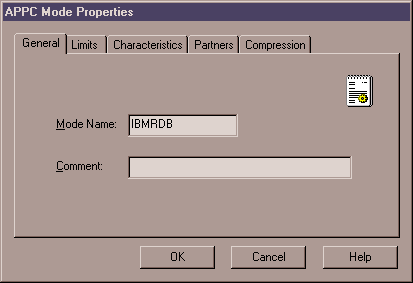
- Enter the Mode Name (6) in the Mode Name field.
- Select the Limits tab.
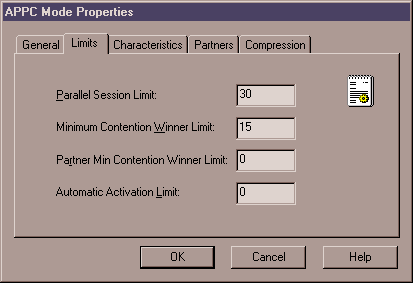
- Enter appropriate numbers for the Parallel Session Limit and
Minimum Contention Winner Limit fields. Your Host-Side or
LAN administrator should be able to supply you with the numbers if you do not
know the limits you should place here.
- Accept the other defaults, and click on OK.
|
step 8.
| Define the CPIC name properties
- Right-click on CPIC Symbolic Name folder icon and select the
Insert->APPC->CPIC Symbolic Name option. The CPIC Name
Properties window opens.
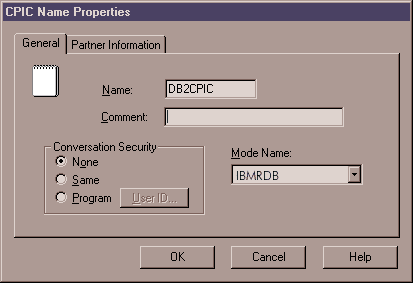
- Enter the Symbolic Destination Name ((16)) in the Name
field.
- Click on the Mode Name drop down box and select a mode name,
for example, IBMRDB.
- Select the Partner Information tab.
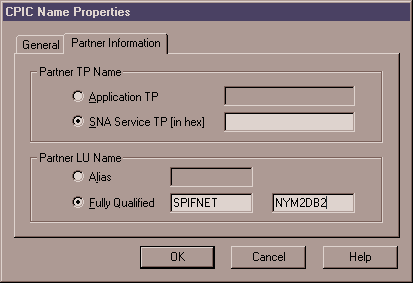
- In Partner TP Name box, select the SNA Service TP (in
hex) radio button and enter the Service TP name ((17)), or select
the Application TP radio button and enter the Application TP name
((17)).
- In the Partner LU Name box, select the Fully
Qualified radio button.
- Enter the fully-qualified Partner LU Name ((1) and (2)) or
alias.
- Click on OK.
- Save the configuration
- Select File->Save from the menu bar of the Server Manager
window. The Save File window opens.
- Type a unique name for your configuration into the File Name
field.
- Click on the Save push button.
|
Read this section if you have a Windows NT workstation that
has DB2 Connect installed. This section provides step-by-step
instructions for setting up the communications between your DB2 Connect
workstation and a Windows NT workstation that has Microsoft SNA Server
V4.0 (or later) installed.
Figure 2 illustrates the example DB2 Connect Server scenario.
Figure 2. Indirect Connection to host or AS/400 database server via SNA Communications Gateway
The rest of this section assumes:
- The Microsoft SNA Server has already been configured for APPC
communications with the host, and is enabled for ODBC and DRDA. Refer
to the Microsoft SNA Server documentation for further information.
- Microsoft SNA Client Version 2.11 is not already installed on your
DB2 Connect workstation.
To configure the Microsoft SNA client perform the following steps:
For your Microsoft SNA client software to function properly you must
have access to a properly configured Microsoft SNA Server. Request that
your SNA Server administrator:
step 1.
| Obtain the proper license for you to use Microsoft SNA Client on your
workstation.
|
step 2.
| Define a user ID and password for you on the SNA Server domain.
|
step 3.
| Define connections to the host and AS/400 databases that you need to
access, as described in Configuring Microsoft SNA Server for Windows NT.
|
step 4.
| Provide you with the symbolic destination name ((16)), database
name ((5)), and user account to use for each database connection
defined in the previous step.
If you plan to change host passwords, the SNA administrator will also need
to provide you with symbolic destination names for password management tasks
on each host.
|
step 5.
| Provide you with the Microsoft SNA Server domain name and the protocol
used for communicating with the SNA server (TCP/IP, NetBEUI,
IPX/SPX).
|
- Obtain the Microsoft SNA Client software, and follow its instructions to
start the installation program.
- Follow the instructions on the screen to complete the installation.
Choose your SNA Server domain name and communication protocol according to the
instructions provided by your SNA Server administrator.
- When you reach the Optional Components window, deselect Install
ODBC/DRDA driver so that it will not be installed.
- Complete the installation.
step 1.
| Install DB2 Connect.
|
step 2.
| Click on the Start button and select Programs->DB2 for
Windows NT->Client Configuration Assistant.
|
step 3.
| You need to provide the following information:
__ a.
| The Symbolic destination name ((16)) defined at the Microsoft SNA
Server for the Partner LU ((2)) of the target host or AS/400 database
server.
| __ b.
| The real database name ((5)).
|
|
This section describes how to configure IBM eNetwork Communication Server
V5.0.2.5 for AIX on your DB2 Connect workstation to
connect to host or AS/400 database servers using APPC. IBM eNetwork
Communication Server for AIX is the only SNA product supported for DB2 Connect
running on RS/6000 machines.
Before you begin, ensure that your workstation has IBM eNetwork
Communication Server V5.0.2.5 for AIX (CS/AIX)
installed. If you need further information in order to configure your
SNA environment, refer to the online help provided with CS/AIX.
The following assumptions are made:
- The basic installation of the IBM eNetwork Communication Server V5 for AIX
package has already been completed.
- DB2 Connect has been installed.
- The user is logged on as root.
To configure CS/AIX for use by DB2 Connect, log on to the system as a user
with root authority and use either the /usr/bin/snaadmin
program or the /usr/bin/X11/xsnaadmin program. Information
about these programs can be found in the system documentation. The
following steps describe how to use the xsnaadmin program to
configure CS/AIX.
step 1.
| Enter the command xsnaadmin. The Node window for the
server opens.
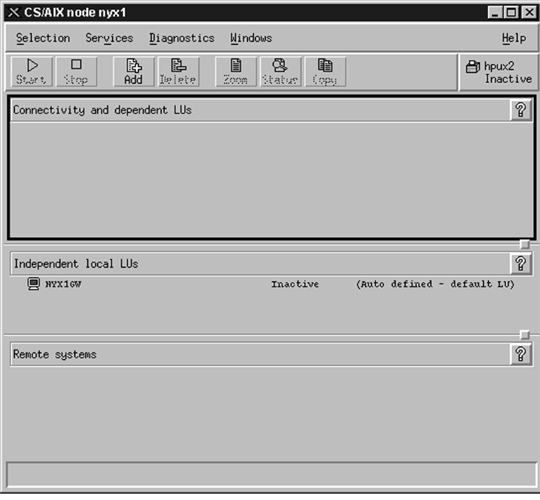
|
step 2.
| Define a Node
- Select Services->Configure Node Parameters. The Node
Parameters window opens.
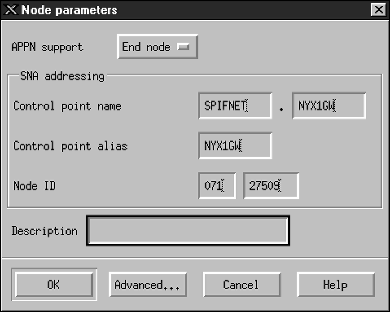
- Select End node from the APPN support drop-down
menu.
- Enter your Network ID and the Local PU Name ((9) and (10))
in the Control point name fields.
- Enter Local PU Name ((10)) in the Control point alias
field.
- Enter your Node ID ((13) and (14)) in the Node ID
fields.
- Click on OK.
|
step 3.
| Define a port
- Select the Connectivity and Dependent LUs windows.
- Click on the Add push button. The Add to Node window
opens.
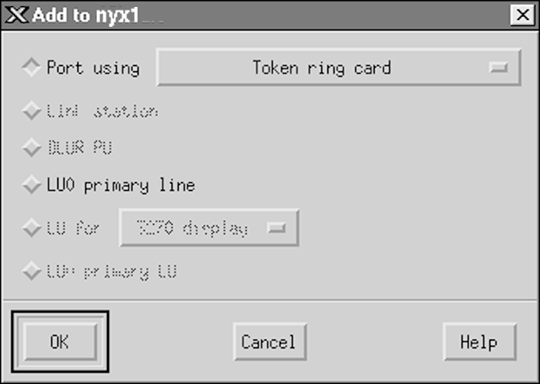
- Select the Port using radio button.
- Click on the Port Using drop down box and select the
appropriate port type.

| For our example, we will select the the Token ring card
option.
|
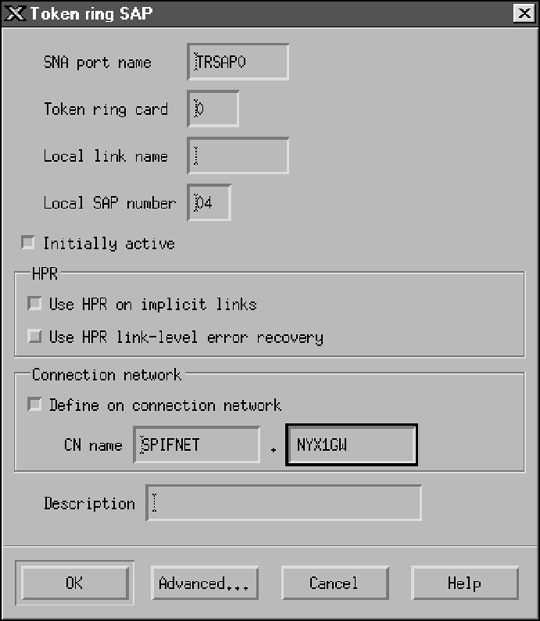
- Click on OK. The Port window for the chosen port type
opens.
- Enter a name for the port in the SNA port name field.
- Select the Initially active check box.
- From the Connection network box, select Define on
connection network check box.
- Enter your SNA Network Name ((9)) in the first part of the CN
name field.
- Enter the Local PU Name ((10)) associated with your AIX computer in
the second part of the CN name field.
- Click on OK. The Port window closes and a new
port opens in the Connectivity and Dependent LUs window.
|
step 4.
| Define a link station
- In the Connectivity and Dependent LUs window, select the port
that you defined in the previous step.
- Click the Add push button. The Add to Node window
opens.
- Select the Add a link station to port radio button.
- Click on OK. The Token ring link station window
opens.
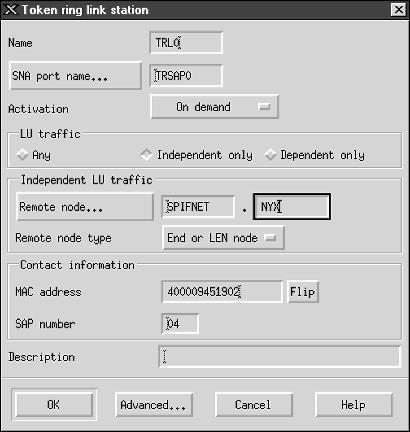
- Enter a name for the link in the Name field.
- Click on the Activation drop down box and select the On
demand option.
- Select the Independent only option in the LU traffic
box.
- In the Independent LU traffic box:
- Enter the Network ID ((3)) and the Partner LU Name ((2)) in
the Remote Node fields.
- Click on the Remote node type drop down box and select the type
of node that applies to your network.
- In the Contact information box, enter the SNA Destination
Address ((8)) assigned for the host or AS/400 system in the Mac
address field.
- Click on OK. The Link Station window closes and a new
link station appears in the Connectivity and Dependent LUs
window.
|
step 5.
| Define a local LU
- Select the Independent local LUs window.
- Click on the Add push button. The Local LU window
opens.
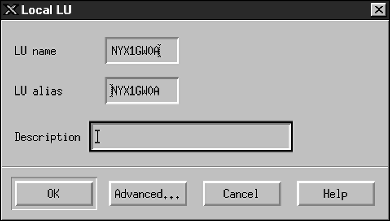
- Enter your independent local LU Name ((11)) in the LU
name field.
- Enter the same name in the LU alias field ((12)).
- Click on OK. The new LU appears in the Independent
local LUs window.
|
step 6.
| Define a partner LU over the link station
- Select Services->APPC->New PLUs->Over link station from the
menu bar. The Partner LU on link station window opens.
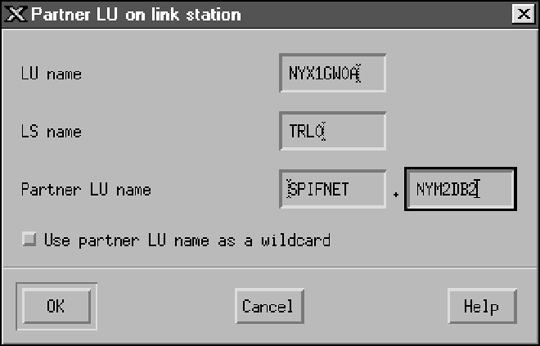
- Enter the name for the Local LU ((11)) you defined previously in
the LU name field.
- Enter the name for the Link station you defined previously in the LS
name field.
- Enter the name of the Partner LU you want to connect to ((2)) in
the Partner LU name fields.
- Click on OK. The Partner LU appears in the
Independent Local LUs window of the Local LU that was created in
the previous step.
|
step 7.
| Define an alias for the partner LU
- Select the Remote Sytems window.
- Click on the Add push button. The Add to node window
opens.
- Select the Define partner LU alias radio button.
- Click on OK. The Partner LU window opens.
- Enter an alias for the partner LU in the Alias field.
- Enter the same value in the Uninterpreted name field.
- Click on OK.
|
step 8.
| Define a mode
- Select Services->APPC->Modes from the menu bar. The
Modes window opens.
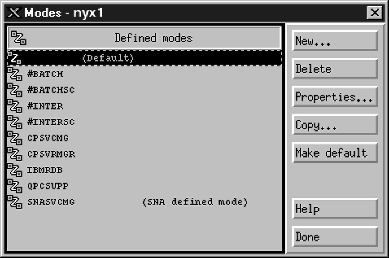
- Click on the New push button. The Mode window
opens.
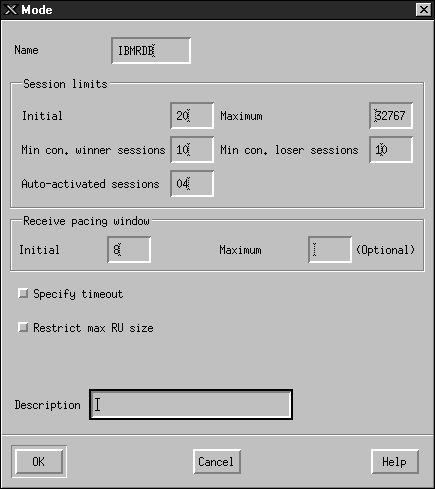
- Enter a mode name ((15)) in the Name field.
- The configuration values below are suggested for the following
fields:
- Initial Session limits: 20
- Maximum Session limits: 32767
- Min con. winner sessions: 10
- Min con. loser sessions: 10
- Auto-activated session: 4
- Initial Receive pacing window: 8
These values are suggested because they are known to work. You will
need to tailor these values so that they are optimized for your particular
application environment.
- Click on OK. The new mode appears in the Modes
window.
- Click on Done.
|
step 9.
| Define the CPI-C destination name
- Select Services->APPC->CPI-C from the menu bar. The
CPI-C destination names window opens.
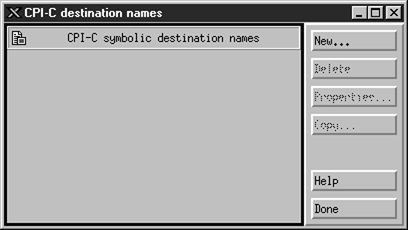
- Click on the New push button. The CPI-C destination
window opens.
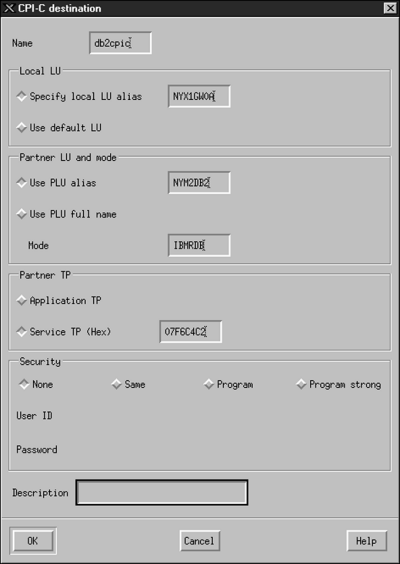
- Enter the Symbolic Destination Name ((16)) you want to associate
with the host or AS/400 server database in the Name field.
This example uses DB2CPIC.
- In the Partner TP box:
- For DB2 for MVS/ESA, DB2 for OS/390, and DB2 for AS/400, select the
Service TP (hex) radio button, and enter the hexadecimal TP number
((17)). (For DB2 Universal Database for OS/390 or DB2/MVS, you
can also use the default application TP DB2DRDA. For DB2 for
AS/400 you can also use the default application TP
QCNTEDDM.)
- For DB2 for VM or VSE, select the Application TP radio
button. For DB2 for VSE, enter the DB2 for VM database name. For
DB2 for VSE, enter the AXE as the application TP. ((17))
- In the Partner LU and mode box:
- Select the Use PLU Alias radio button, and enter the Partner LU
Alias ((2)) you created in a previous step.
- Enter the Mode name ((15)) for the mode that you created in a
previous step in the Mode field.
- In the Security box, select the radio button that corresponds
to the type of security level that you want to run on your network.
- Click on OK. The new destination name appears in the
Destination names window.
- Click on Done.
|
step 10.
| Test the APPC connection
- Start the SNA subsystem by entering the /usr/bin/sna start
command. You can enter the /usr/bin/sna stop command to stop
the SNA subsystem first, if required.
- Start the SNA administration program. You can enter either the
/usr/bin/snaadmin command or the /usr/bin/X11/xsnaadmin
command.
- Start the subsystem node. Select the appropriate node icon in the
button bar, and click on the Start push button.
- Start the link station. Select the link station you defined
previously in the Connectivity and Dependent LUs window, and click
on the Start push button.
- Start the session. Select the LU you defined previously in the
Independent Local LUs window, and click on the Start
push button. A session activation window opens.
- Select or enter the Partner LU and Mode desired.
- Click on OK.
|

| You may also need to contact your database or network administrators to
have your Local LU names added to the appropriate tables in order to access
the host or AS/400 server database.
|
This section describes how to configure Bull DPX/20 SNA/20
Server on your DB2 Connect workstation to connect to host or AS/400 database
servers using APPC. If Bull DPX/20 SNA/20 Server is installed prior to
installing DB2 Connect, DB2 Connect uses Bull SNA. Otherwise, you need
to configure DB2 Connect to work with IBM eNetwork Communications Server
V5.0.2.5 for AIX. See Configuring IBM eNetwork Communication Server for AIX for more information.
To determine if Bull SNA is installed on your AIX 4.1.4 (or
later) system, enter the following command:
lslpp -l express.exsrv+dsk
If Bull SNA is installed, you will see output similar to the
following:
Fileset Level State Description
----------------------------------------------------------------------
Path: /usr/lib/objrepos
express.exsrv+dsk 2.1.3.0 COMMITTED EXPRESS SNA Server and
Integrated Desktop
If you install Bull SNA after installing DB2 Connect and you want DB2
Connect to use Bull SNA instead of IBM eNetwork Communications Server for AIX,
log on to the system as a user with root authority and enter the
following command:
/usr/lpp/db2_06_01/cfg/db2cfgos
If you want to install the Bull DPX/20 SNA/20 Server, then you must have
the following software:
__ 1.
| AIX V4.1.4
|
__ 2.
| Express SNA Server V2.1.3
|
For more information on setting up your SNA environment, refer to the Bull
DPX/20 SNA/20 Server Configuration Guide.

| DB2 Connect, when used with the Bull SNA server, cannot have inbound APPC
connections from remote clients. The only APPC connections it can have
are outbound APPC connections to the host.
|
To configure Bull SNA for use by DB2 Connect, enter the express
command to configure the following SNA parameters:
Config Express Default configuration for EXPRESS
Node NYX1 SPIFNET.NYX1 (HOSTNAME=NYX1)
Indep. LUs 6.2 LUs Using All Stations
LU NYX1 Control Point LU
Link tok0.00001 Link (tok0)
Station MVS To MVS from NYX1
LU NYX1GW01 To MVS from NYX1
LU Pair NYM2DB2 To MVS from NYX1
Mode IBMRDB IBMRDB
Use default values for fields not listed.
The following example illustrates the sample configuration:
Defining hardware:
System (hostname) = NYX1
Adapter and Port = NYX1.tok0
MAC Address = 400011529778
Defining SNA node:
Name = NYX1
Description = SPIFNET.NYX1 (HOSTNAME=NYX1)
Network ID = SPIFNET
Control Point = NYX1
XID Block = 05D
XID ID = 29778
Defining token ring link:
Name = tok0.00001
Description = Link (tok0)
Connection Network name
Network ID = SPIFNET
Control Point = NYX
Defining token ring station:
Name = MVS
Description = To MVS from NYX1
Remote MAC address = 400009451902
Remote Node name
Network ID = SPIFNET
Control Point = NYX
Defining Local LU 6.2:
Name = NYX1GW01
Description = To MVS from NYX1
Network ID = SPIFNET
LU name = NYX1GW01
Defining Remote LU 6.2:
Name = NYM2DB2
Description = To MVS from NYX1
Network ID = SPIFNET
LU name = NYM2DB2
Remote Network ID = SPIFNET
Remote Control Point = NYX
Uninterpreted Name = NYM2DB2
Defining Mode:
Name = IBMRDB
Description = IBMRDB
Class of service = #CONNECT
Defining Symbolic Destination Info:
Name = DB2CPIC
Description = To MVS from NYX1
Partner LU = SPIFNET.NYM2DB2
Mode = IBMRDB
Local LU = NYX1GW01
Partner TP = DB2DRDA
After you have configured these SNA parameters, you must stop and start the
SNA server. To do this, perform the following steps:
step 1.
| Log on to the system as a user with root authority.
|
step 2.
| Make sure your PATH contains the $express/bin
(/usr/lpp/express/bin)entry.
|
step 3.
| Check for active users before stopping the server by entering the
following command:
express_adm shutdown
|
step 4.
| Stop all EXPRESS activity by entering the following command:
express_adm stop
|
step 5.
| Start EXPRESS by entering the following command:
express_adm start
|
This section describes how to configure SNAplus2 for HP-UX on your DB2
Connect workstation to connect to host or AS/400 database servers using
APPC. SNAplus2 for HP-UX is the only SNA product supported for DB2
Connect running on HP-UX V10 and V11 machines.
Before you begin, ensure that your workstation has HP-UX SNAplus2
installed. If you need more information in order to configure your SNA
environment, refer to the online help provided with SNAplus2.
The following assumptions are made:
- The basic installation of the SNAplus2 for HP-UX package has already been
completed.
- DB2 Connect has been installed.
- The user is logged on as root.
To configure SNAplus2 for DB2 Connect, log on to the system as a user with
root authority and use either the /opt/sna/bin/snapadmin
program or the /opt/sna/bin/X11/xsnapadmin program.
Information about these programs can be found in the system
documentation. The following steps describe how to use the
xsnapadmin program to configure SNAplus2.
step 1.
| Enter the command xsnapadmin. The Node window for the
server opens.
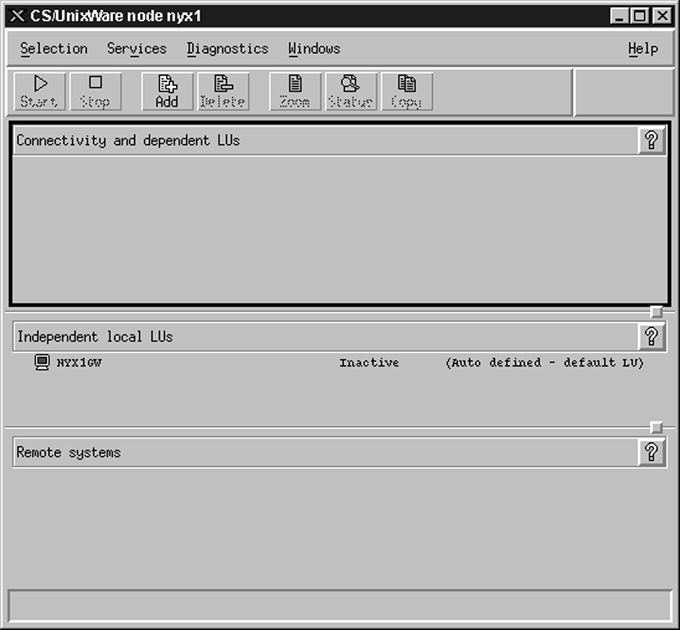
|
step 2.
| Define a Node
- Select Services->Configure Node Parameters. The Node
Parameters window opens.

- Select End node from the APPN support drop-down
menu.
- Enter your Network ID and the Local PU Name ((9) and (10))
in the Control point name fields.
- Enter Local PU Name ((10)) in the Control point alias
field.
- Enter your Node ID ((13) and (14)) in the Node ID
fields.
- Click on OK.
|
step 3.
| Define a port
- Select the Connectivity and Dependent LUs window.
- Click on the Add push button. The Add to Node window
opens.
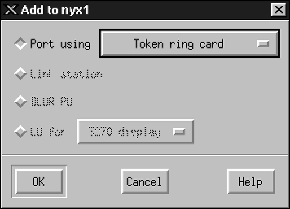
- Select the Port using radio button.
- Click on the Port Using drop down box and select the
appropriate port.

| For our example, we will select the Token ring card
option.
|
- Click on OK. The Port window for the chosen port type
opens.
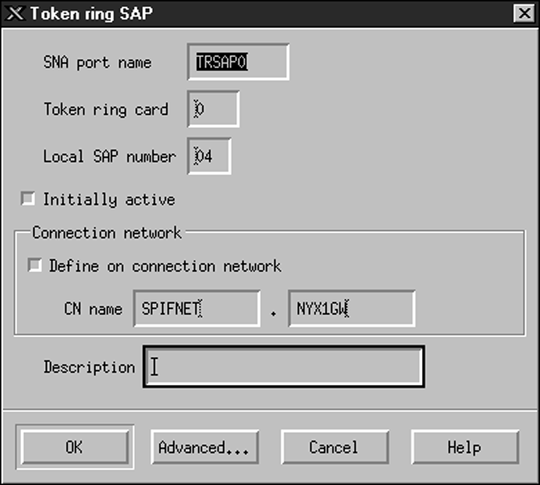
- Enter a name for the port in the SNA port name field.
- Select the Initially active check box.
- Select the Define on a connection network check box.
- Enter your Network ID ((9)) in the first part of the CN
name field.
- Enter your local Control Point name ((10)) in the second part of
the CN name field.
- Click on OK. The Port window closes and a new
port appears in the Connectivity and Dependent LUs window.
|
step 4.
| Define a link station
- In the Connectivity and Dependent LUs window, select the port
that you defined in the previous step.
- Click the Add push button. The Add to Node window
opens.
- Select the Add a link station to port radio button.
- Click on OK. The Token ring link station window
opens.

- Enter a name for the link in the Name field.
- Click on the Activation drop down box and select the On
demand option.
- Select the Independent only option in the LU traffic
box.
- In the Independent LU traffic box:
- Enter the Network ID ((3)) and the Partner LU Name ((2)) in
the Remote Node fields.
- Click on the Remote node type drop down box and select the type
of node that applies to your network.
- In the Contact information box, enter the SNA Destination
Address ((8)) assigned for the host or AS/400 system in the Mac
address field.
- Click on OK. The Link Station window closes and a new
link station appears in the Connectivity and Dependent LUs
window.
|
step 5.
| Define a local LU
- Select the Independent local LUs window.
- Click on the Add push button. The Local LU window
opens.

- Enter your independent local LU Name ((11)) in the LU
name field.
- Enter the same name in the LU alias field ((12)).
- Click on OK. The new LU appears in the Independent
local LUs window.
|
step 6.
| Define a remote node
- Select the Remote Systems window.
- Click on the Add push button. The Add to Node window
opens.
- Select Define remote node.
- Click on OK. The Remote Node configuration window
appears.
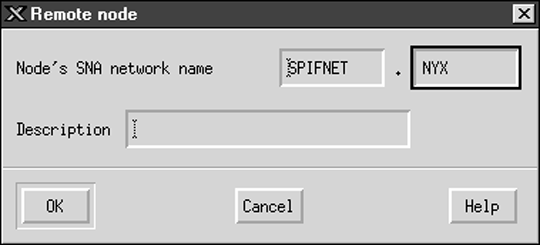
- Enter the Network ID ((3)) and the Partner LU Name ((2)) in
the Node's SNA network name field.
- Click on OK. The remote node appears in the Remote
Systems window, and a default partner LU is defined for the node.
|
step 7.
| Define a partner LU
- In the Remote Systems window, double-click the default partner
LU that was created when you defined a remote node in the previous
step. The Partner LU window opens.
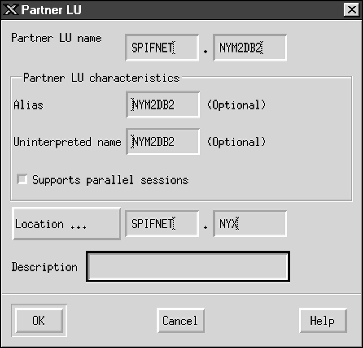
- Enter the same Partner LU name ((2)) in the Alias and
Uninterpreted name fields.
- Select Supports parallel sessions.
- Click on OK.
|
step 8.
| Define a mode
- Select Services->APPC->Modes from the menu bar. The
Modes window opens.

- Click on the New push button. The Mode window
opens.

- Enter a mode name ((15)) in the Name field.
- The configuration values below are suggested for the following
fields:
- Initial Session limits: 20
- Maximum Session limits: 32767
- Min con. winner sessions: 10
- Min con. loser sessions: 10
- Auto-activated session: 4
- Initial Receive pacing window: 8
These values are suggested because they are known to work. You will
need to tailor these values so that they are optimized for your particular
application environment.
- Click on OK. The new mode appears in the Modes
window.
- Click on Done.
|
step 9.
| Define the CPI-C destination name
- Select Services->APPC->CPI-C from the menu bar. The
CPI-C destination names window opens.

- Click on the New push button. The CPI-C destination
window opens.

- Enter the Symbolic Destination Name ((16)) you want to associate
with the host or AS/400 server database in the Name field.
This example uses DB2CPIC.
- In the Partner TP box:
- For DB2 for MVS/ESA, DB2 for OS/390, and DB2 for AS/400, select the
Service TP (hex) radio button, and enter the hexadecimal TP number
((17)). (For DB2 Universal Database for OS/390 or DB2/MVS, you
can also use the default application TP DB2DRDA. For DB2 for
AS/400 you can also use the default application TP
QCNTEDDM.)
- For DB2 for VM or VSE, select the Application TP radio
button. For DB2 for VSE, enter the DB2 for VM database name. For
DB2 for VSE, enter the AXE as the application TP. ((17))
- In the Partner LU and mode box:
- Select the Use PLU Alias radio button, and enter the Partner LU
Alias ((2)) you created in a previous step.
- Enter the Mode name ((15)) for the mode that you created in a
previous step in the Mode field.
- In the Security box, select the radio button that corresponds
to the type of security level that you want to run on your network.
- Click on OK. The new destination name appears in the
Destination names window.
- Click on Done.
|
step 10.
| Test the APPC connection
- Start the SNA subsystem by entering the /opt/sna/bin/sna start
command. You can enter the /opt/sna/bin/sna stop command to
stop the SNA subsystem first, if required.
- Start the SNA administration program. You can use either the
/opt/sna/bin/snaadmin command, the
/opt/sna/bin/X11/xsnaadmin command.
- Start the subsystem node. Select the appropriate the node icon in
the button bar, and click the Start push button.
- Start the link station. Select the link station you defined
previously in the Connectivity and Dependent LUs window, and click
on the Start push button.
- Start the session. Select the LU you defined previously in the
Independent Local LUs pane, then click on the Start
button. A session activation window opens. Select or enter the
Partner LU and Mode desired.
- Click on OK.

| You may also need to contact your database or network administrators to
have your Local LU names added to the appropriate tables in order to access
the host or AS/400 server database.
|
|
This section describes how to configure SunLink SNA PU 2.1 (SunLink
SNA) for Solaris on your DB2 Connect workstation to connect to host or AS/400
database servers using APPC. SunLink SNA for Solaris is the only SNA
product supported for DB2 Connect running on Solaris.
Before you begin, ensure that your workstation has SunLink SNA
installed. If you need further information in order to configure your
SNA environment, refer to the SunLink PU 2.1 Server Configuration
and Administrator's Manual.
The following assumptions are made:
- The basic installation of the SunLink SNA PU 2.1 for Solaris
package has already been completed.
- DB2 Connect has been installed.
- The user is logged on as root.
To configure the SunLink SNA Server for use by DB2 Connect, log on to the
system as a user with root authority and perform the following
steps:
| Note: | You may also need to contact your database or network administrators to have
your Local LU names added to the appropriate tables in order to access the
host or AS/400 server database.
|
You can use any plain text editor to create the CPIC
side file. The file must be placed in the application's path for a
standalone DB2 Connect for Solaris system. However, for remote DB2
clients to be able to access it on the DB2 Connect for Solaris system, the
file should be in one of the following directories:
- INSTHOME/sqllib/adm or
- INSTHOME/sqllib/bin
| Note: | The name of the CPIC side file must be the same as the symbolic destination
name specified in the DB2 node directory on the DB2 Connect for Solaris
system.
|
The example below shows the CPIC side file sections required for
configuring the SunLink SNA to connect to host or AS/400 database
servers.
# CPIC Side File information
#
PTNR_LU_NAME=NYM2DB2
MODE_NAME=IBMRDB
TP_NAME=X'07F6C4C2'
SECURITY=PROGRAM
You can use any plain text editor to create the
SNA server configuration file. This file is called
sunpu2.config, and it must be placed in
/opt/SUNWpu21, or the directory where SunLink SNA PU 2.1
Server is installed.
The following example shows the configuration file sections required for
configuring the SunLink SNA to connect to host or AS/400 database
servers. Other sections that are not shown are required for accepting
inbound APPC connections.
// SunLink SunLU6.2/SunPU2.1 SNA Server Sample Configuration
// Token Ring Peer-to-Peer System A @(#)sunlu62.a.tr
//
// The physical connection is a Token Ring interface adapter.
CP NAME=NYX1 // Local name (8 char max)
NQ_CP_NAME=SPIFNET.NYX1 // Network Qualified Name
window opens
TRLINE NAME=MAC1 // SunLink specific name
SOURCE_ADDRESS=x'400011527509' // sysA_mac_addr for Sun machine
window opens
DLC NAME=HOSTLINK // User defined name (8 char max)
LINK_NAME=MAC1 // Line name this station is on
LCLLSAP=x'04' // Local Link Service Access Point
RMTLSAP=x'04' // Remove Link Service Access Point
RMTMACADDR=x'400009451902 // sysB_mac_addr
TERMID=x'07127509' // XID negotiation
window opens
LU NAME=NYX1GW0A // Local name (8 char max)
NQ_LU_NAME=SPIFNET.NYX1GW0A // Network Qualified Name
SESS_LMT=50 // Max LU sessions
LUTYPE=6.2
window opens
PTNR_LU NAME=NYM2DB2 // Partner LU name(8 char max)
LOC_LU_NAME=NYX1GW0A // Associated Local LU
NQ_LU_NAME=SPIFNET.NYM2DB2 // Network Qualified Name
window opens
MODE NAME=IBMRDB // Mode Name (8 char max)
DLC_NAME=HOSTLINK // Associated DLC
PTNR_LU_NAME=NYM2DB2 // Associated Partner LU
LCL_MAX_SESS_LMT=30 // Max Session Limit
MIN_CW_SESS=15 // Min Conwinners
MIN_CL_SESS=15 // Min Conlosers
window opens
In order to run any application, you must set the
following environment variables:
- APPC_GATEWAY
- Name of the DB2 for Solaris server (usually the TCP/IP hostname).
- APPC_LOCAL_LU
- Name of the local LU name provided in the SNA configuration file.
For a DB2 Connect for Solaris server, export these on the DB2 Connect
machine before proceeding with the next step.
To start the SunLink SNA subsystem, perform the following
steps:
step 1.
| Change to the SunLink installation directory, usually:
cd /opt/SUNWpu21
|
step 2.
| Set up environment variables for FlexLM licensing. For
example:
export LD_LIBRARY_PATH=/usr/openwin/lib:/usr/lib
export LM_LICENSE_FILE=/etc/opt/licenses/licenses_combined
Refer to the SunLink documentation for full details.
|
step 3.
| Ensure you have created the CPIC side file.
|
step 4.
| Ensure you have created the SNA server configuration file.
|
step 5.
| Use the sunop utility to check the status of SunLink SNA if it
is already started.
Check to see if the PU and/or DLC status is connected.
You can also use sunop to check the status of links.
Refer to the SunLink documentation for details of the sunop
utility.
|
step 6.
| Stop SunLink if it is active. For example, enter:
kill -9 sunpu2.pid
kill -9 sunlu2.pid
|
step 7.
| Start SunLink using the following command:
sunpu2.1
|
[ Top of Page | Previous Page | Next Page | Table of Contents | Index ]
[ DB2 List of Books |
Search the DB2 Books ]






































